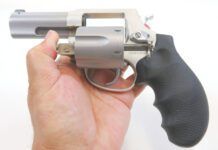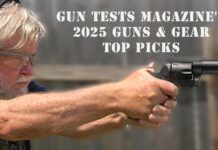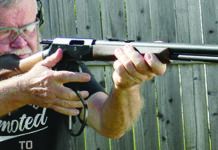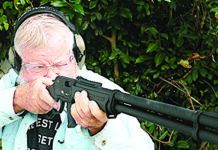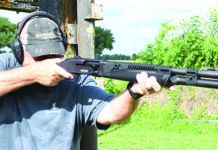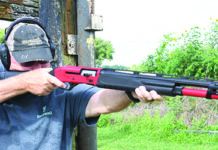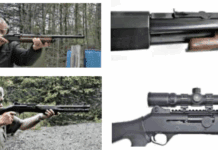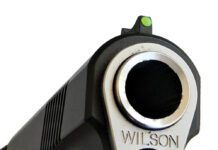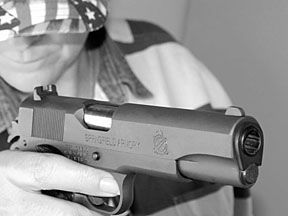
It is no wonder that the average price of a 1911 .45 ACP pistol has put this weapon out of the reach of many buyers. The temptation for manufacturers to offer more and more features such as night sights, checkering, skeletonized hammers, and so on is substantial, since each upgrade can be marked up and the net profit per pistol improved.
We shopped around for reasonably priced 1911s, with the definition of “reasonably priced” being something of a moving target. What’s reasonable in a marketplace dominated by polymer sidearms that are fine defense guns, and which sell for hundreds of dollars less?
But we did find two pistols very close to military specification, or mil-spec for short, that in fact boast manufacturer’s suggested retail prices under $600. They were the Auto Ordnance 1911PKZ, $515, and the Springfield Armory Mil-Spec Parkerized Model PB9108L, $559. Both pistols were treated to a flat-black Parkerized finish. Our hope was that their price tags were the results of saving money on parts and not on workmanship.
[PDFCAP(1)]
Kahr Arms, located north of New York City in the town of Blauvelt, is best known for its lineup of hearty double-action-only pistols. The Kahr K9 and K40 models feed from single-column magazines and feature 3.5-inch barrels, making them a favorite among CHL holders. Compact as well as full-size models are available with choice of steel or polymer frames.
But Kahr Arms has recently expanded its product line to include working reproductions modeled after weapons of the World War II era. One such replica is a semi-automatic version of the Thompson submachine gun, and another is the subject of this evaluation, the Parkerized 1911A1 .45 ACP WWII pistol, item number 1911PKZ. This gun comes by way of Kahr’s acquisition of Auto Ordnance pistols, and the gun is marketed under the Auto Ordnance name.
It is a full-size Government Model 1911 with fixed sights, checkered grip panels, arched mainspring housing, lanyard loop and standard spur hammer — very similar to the famed sidearm stamped with “1911 U.S. Army” on the slide.
The experience of owning the Auto Ordnance replica begins with opening the box and finding it packed in heavy yellowish machine oil. The sensation was that we were unpacking a G.I. pistol that had never been used. But cleaning off the oil we found that the 1911PKZ model was Parkerized, a finish developed by Parker Chemical Company. The flat-black Parkerized finish is supposed to be more corrosion resistant than bluing. Although the Parkerized finish of our Auto Ordnance pistol did a good job of shrugging off chemical cleaners, we noticed scuff marks from ejected brass cases atop the slide and a point on the beavertail where the finish appeared to be wearing off. Still, we liked the flat-black look.
Besides the naturally colored grip panels and stainless-steel barrel, there were no other highlights or accents. The grip panels were composite plastic. The arched mainspring housing was lined, but the front strap was left smooth. Serrations were cleanly applied, but only on the rear of the slide. Several points on this gun reminded us of how many innovations are now standard on today’s 1911 pistols. The trigger was not adjustable, but its face was nicely textured. The thumb safety was left side only, like on the original design, but we were felt that its movement was loose and sloppy, undermining our confidence in its durability.
We also felt there was a distracting interplay between the grip safety and the trigger, as though our grip was coaxing the trigger action along. The hammer showed a full spur with checkering. The beavertail was broad and smooth even by today’s standards. Because the gun used a standard-length guide rod, field-stripping did not require a bushing wrench. Good thing: None was supplied along with the owner’s manual, cable lock and test-fired case. The front sight was also grooved, but we wished it was bigger and bolder. The rear unit was windage adjustable only by impact or drift. The one supplied magazine held seven rounds and utilized a round follower.
We began our [PDFCAP(2)] by shooting a variety of .45 ACP loads at a rack of six 8-inch steel plates mounted 15 yards downrange. The trigger press required 6.5 pounds of pressure to ignite each round, but we thought the action was smooth and consistent. However, we had a great deal of trouble finding the proper point of aim. We estimated that the gun was shooting very low and decided to set up targets that offered blank paper well below our point of aim in order to catch printed groups. We also decided, due to the limitations of the sights, to collect data at 15 yards. This was some 10 yards shy of the distance from which we normally test full-size pistols.
We also found out that our Auto Ordnance would not chamber a variety of hollowpoint ammunition from a fully loaded magazine. Removing the seventh round from the magazine was the only way to get a JHP round into the chamber. Changing to a modern high-quality magazine, the $32 Wilson Combat eight-round magazine, item 47DAB, did not solve this problem. After cracking open several boxes of expensive ammunition we located some 230-grain hollowpoints from Black Hills Ammunition (605-348-5150). In our experience this round is one of the few modern defense loads that will feed in a variety of .45 ACP pistols. The reluctance of the Auto Ordnance to feed hollowpoints was the first clue that we were indeed handling a vintage firearm with classic problems. But since the 1911PKZ fed the Black Hills rounds reliably, we could now evaluate the Auto Ordnance in terms of its defensive capability.
Along with the Black Hills rounds, we also shot 230-grain full-metal-jacket rounds from Federal American Eagle and Winchester USA 185-grain jacketed rounds with truncated cone noses. We also tried a hand load featuring a 200-grain roundnose moly-coated bullet from Precision Bullets (903-498-8457).
We immediately found that the point of impact of the first shot was consistently out of line with subsequent shots. Probable cause: The slide and barrel would not achieve the same lockup when hand-cycled as it would when cycled by ignition.
As expected, the Auto Ordnance pistol printed groups low when firing factory ammunition. Point of impact was off by as much as 5 inches. If we fired the first round off target, we were able to land groups measuring 3.7 and 3.4 inches for the Federal and Winchester ammunition respectively. The Black Hills 230-grain JHP ammunition also delivered groups measuring about 3.5 inches at 15 yards with 330 foot-pounds plus of muzzle energy. Firing the hand load, we were surprised to find out those rounds printed to point of aim. After dumping our first shot, we landed a best group of 2.3 inches. Ultimately, we averaged 2.8 inches with our Precision Bullet hand load.
[PDFCAP(3)]
Based in Geneseo, Illinois, Springfield Armory has built its reputation by manufacturing a full line of 1911-style pistols. The name of the firm refers to the first arsenal designated by George Washington in 1794, which was located in Springfield, Massachusetts until 1968. The name was acquired by Robert Reese in 1974, and initial production centered on the M1A rifle. In the 1980s, the firm began building 1911s.
The pistols choices are wide and varied; some are modern and some are traditional. For example, the Mil-Spec Operator was designed for today’s military and police challenges. But the Springfield Armory Mil-Spec Parkerized is plain Jane in comparison.
In fact, part for part the Springfield Armory product was almost identical to the Auto Ordnance model. This included the arched mainspring, solid spur hammer, checkered plastic grip, left-side-only thumb safety, grooved trigger, rear-only slide cuts, and short guide rod. The only feature markedly different was the sights. On each gun the rear unit was drift adjustable with a centering line scribed into the top of the slide. However, both the front blade and rear notch on the Springfield were taller and easier to read, and they incorporated a white three-dot system.
We found the Parkerized finish on the Springfield to be darker and more durable, based on our examination of the gun after testing, which showed no sign of wear despite equal service time. The hammer on the Springfield was thinner and, as a result, probably lighter. This might improve lock time. The Springfield did not have a lanyard loop, and it relied upon a seven-round magazine with a flat follower. Both guns arrived with only one magazine. The barrel hood of the Springfield was relieved for visual inspection of the chamber with the slide closed. Slide-to-frame fit was solid on the Springfield but loose on the Auto Ordnance model. There was no sensation of interplay between the grip safety and the trigger on the Springfield, and the safety worked with precision.
At the range, we got a better sight picture with the Springfield’s clear modern sights, which translated into better accuracy. When all groups were measured, the average size was 2.6 inches across.
The Federal American Eagle FMJ and the Black Hills JHP led the way with average groups measuring 2.2 and 2.6 inches, respectively. The Federal ammunition helped us print the only sub-2-inch group of the test, measuring just 1.3 inches. Our test ammunition that featured lighter weight bullets delivered groups measuring just less than 3 inches on average and our shots were consistent to point of aim. The Springfield ran with complete reliability.
Gun Tests Recommends
Auto Ordnance 1911PKZ .45 ACP, $515. Don’t Buy. The Auto Ordnance 1911PKZW proved to be a bare bones 1911 that we think would benefit from better sights and more attention to fit and finish. For only $45 more, the Springfield is a much better gun, in our view.
Springfield Armory Mil-Spec PB9108L .45 ACP, $559. Buy It. We think this gun is accurately described as a standard or general issue pistol. Best we could tell, Springfield kept the price low by leaving off a buffet-line of parts rather than cutting corners in construction. If you’re looking for a bare-bones .45, this gun is good enough.
———-
Bonus Test: [PDFCAP(4)]
Along with our two low-end 1911s, we tested and evaluated a 1911A1 Professional from the Springfield Armory Custom Shop. This gun sold for $2400, or about four times the price of our Mil-Specs. The connection was that a customer can send his Springfield Mil-Spec to the Custom Shop and for $1,495, Springfield Armory will apply an upgrade in parts and workmanship called the “Professional” package. Because we recognize that shooters may start with a Mil-Spec gun but may eventually want more performance, we wanted to report if we thought a conversion of this magnitude was worth the money. Here’s what we found.
The Springfield Armory Custom Shop offers a menu of ala carte modifications describing just about anything that can be done to a 1911 style semi-automatic pistol. The featured items on the Custom Shop’s price list are complete guns and package modifications. A package is a specified list of upgrades and modifications performed on the customer’s gun. Packages available from the Custom Shop for 1911 style pistols are the Professional, Competition, Tactical Response, Loaded, and Defense. Prices range from $175 for the Defense package to $1495 for the Professional, which according to the Custom Shop brochure is an upgrade to “the same exacting specifications as the FBI contract model.” The Professional is a complete rebuild, including the installation of a match-grade barrel and complete refinishing. Other parts listed for installation include match hammer and sear, speed trigger, titanium firing pin with extra heavy firing pin spring, beavertail grip safety, ambidextrous thumb safety, low mount Novak rear sight with matching dovetail front sight, 3-dot tritium inserts, magwell, 20-lpi checkering on the front strap, checkered cocobolo grips, beveling of all external parts, deburr complete pistol internally, apply a “Black T” finish to the complete pistol and ship with six Metalform seven-round magazines tuned to the pistol.
Parts are important, but the Custom Shop offers hand fitting and hand checkering. For example, the benefit of the magazine well would be lost if not for a careful blend with the bevel on the frame.
Springfield prefers to work on carbon-steel-framed pistols, like the Mil-Spec tested above. We were advised that the Black T finish could overcoat the Parkerizing. Turn around time was another consideration, and currently this job would take about 24 weeks. In our experience this is about average for building a custom gun.
To preview what to expect from transforming our pistol into the Professional package, we acquired a completed Custom Shop Professional model pistol in .45 ACP. The Professional and both Mil-Specs from Auto Ordnance and Springfield Armory weighed in between 36 and 38 ounces, but the Professional felt more like one solid block of steel. The Black T finish left the frame with a slight matte exterior, but the slide was a gleaming ink-like blue. We also noticed that the barrel extended well past the bushing, probably because the tube measured 5.1 inches in length. The barrel did not have a cutaway for visual chamber check. The hood was blued and fit tightly against the breech, adding to its solid appearance. The words Nowlin .45 ACP were barely visible on the barrel; Nowlin is a manufacturer of top-quality barrels. The standard length guide rod was retained, but the tight bushing fit required the use of a wrench. The slide-stop pin had been machined flush with the right side of the frame and beveled to prevent any possibility of it being pressed and causing a stoppage. The ambidextrous safeties were narrow but easy to use, blending in with the profile of the grips. The low-mount rear night sight by Novak was sunk cleanly into the slide, with the rear notch as far to the rear as possible. The dovetail of the front-sight blade all but disappeared into the slide. Frame checkering was ultra clean, and the magwell was melded neatly in place. The mainspring housing was flat. The grip safety did offer a raised area to ensure activation.
The Professional arrived with six seven-round magazines made by Metalform, all of which worked perfectly. Each magazine was fit with a rubber base pad to extend its length far enough below the magazine well to allow for positive loading and add durability to the magazines should they be dropped.
Our inspection revealed only one variation from what was promised. The brochure listed a custom-tuned 4.5-pound trigger pull, but we measured the trigger pull to be some 6 pounds, which was actually more in line with our production models. A call to the Custom Shop assured us that weight of trigger pull can be specified, but for carry Springfield Armory does not recommend setting the trigger to less than 4.5 pounds.
In our head to head match up of the Mil-Specs, we had deferred to the poor sights on the Auto Ordnance and collected accuracy data at 15 yards. Taking the Professional [PDFCAP(5)] we felt no such restriction and fired 25 yards downrange from a rest to determine accuracy. We used the very same ammunition to test the Custom Shop Professional as we did in our test of the Mil-Spec models. The Federal American Eagle 230-grain FMJ rounds produced groups that varied between 2.2 and 2.5 inches. The Winchester USA 185-grain FMJ rounds varied in group size from 2.0 to 2.4 inches. Our handload featuring the 200-grain moly-coated Precision bullet and Hodgdon Clays powder varied in group size from 1.9 to 2.6 inches. But our top performer was the Black Hills 230-grain JHP round. The Black Hills ammunition consistently printed five-shot groups measuring 1.8 to 1.9 inches across.
Gun Tests Recommends
Springfield Armory Custom Shop Professional PC9111, $2,400. Conditional Buy. Because the Professional reflects what the Mil-Spec Springfield can become with further work, it’s worth filing away for that day you hit the lottery. We can’t imagine anyone being dissatisfied with the result.




